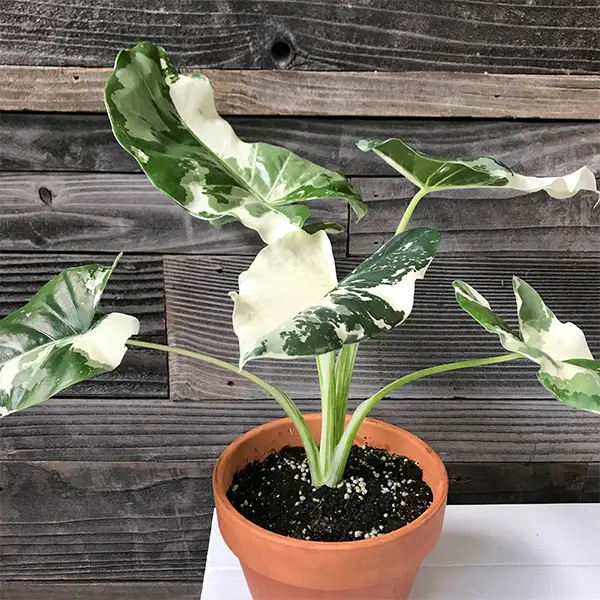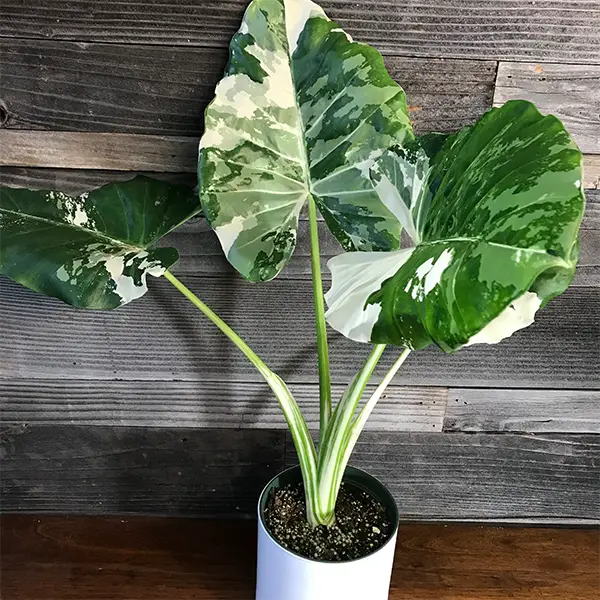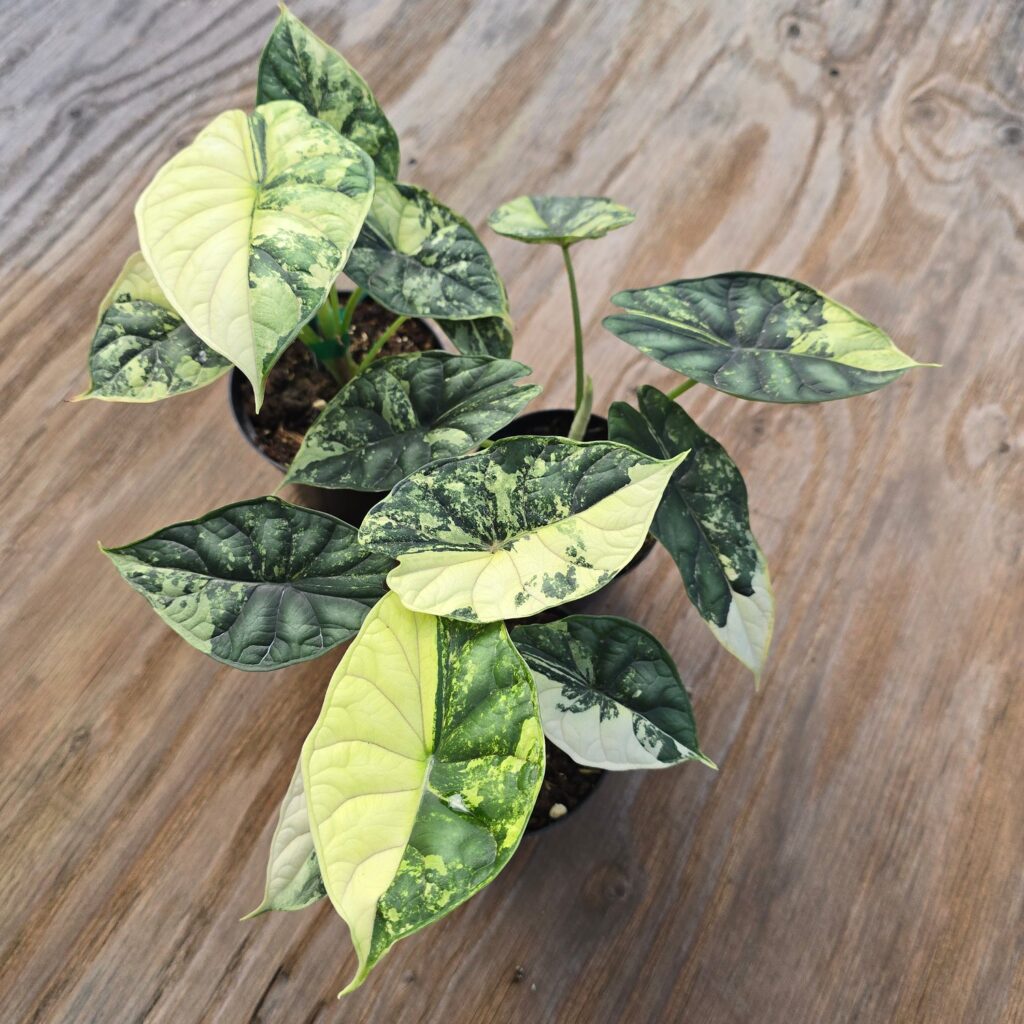Alocasia Albo, known for its striking white and green foliage, can be propagated through division or offsets. The key to successful care includes providing bright indirect light, maintaining high humidity, and ensuring well-draining soil.
Understanding Alocasia Albo
Alocasia Albo, also known as Alocasia ‘White Dragon’, is a popular houseplant admired for its stunning leaves. Native to tropical regions of Southeast Asia, this plant thrives in warm, humid environments. Its unique variegation makes it a favorite among plant enthusiasts, but it does require specific care to flourish indoors.

The leaves of Alocasia Albo can reach impressive sizes, often featuring a striking contrast between the deep green and white areas. This dramatic appearance makes it an eye-catching addition to any indoor space. However, potential growers should be aware of the plant’s particular needs in terms of light, water, and humidity.
Propagation Methods
There are two primary methods for propagating Alocasia Albo: division and offsets. Each method has its benefits and can be chosen based on the grower’s preference and the size of the plant.
1. Division
Division is a straightforward way to propagate your Alocasia Albo. It involves separating the rhizomes, which are the underground stems where roots and new shoots develop. Here’s how to do it:
- Carefully remove the plant from its pot.
- Gently shake off excess soil to expose the rhizomes.
- Identify natural divisions in the root system; each division should have at least one healthy leaf and some roots.
- Use a clean knife or scissors to cut through the rhizomes.
- Replant each division in its own pot with fresh potting mix.
2. Offsets
Offsets are small plants that grow at the base of the main plant. These can also be removed and propagated separately:
- Locate offsets that are large enough to handle.
- Carefully detach them from the mother plant, ensuring they have some roots attached.
- Plant them in individual pots with a suitable potting mix.
Care Tips for Alocasia Albo
After propagating Alocasia Albo, it is essential to provide proper care for optimal growth. Here are some key care tips:
Light Requirements
Alocasia Albo thrives in bright, indirect light. Direct sunlight can scorch the leaves, leading to damage. A location near a window with filtered light is ideal.

Watering
This plant prefers consistently moist soil but should not be waterlogged. Allow the top inch of soil to dry out before watering again. Overwatering can lead to root rot, a common issue with Alocasia plants.
Humidity
High humidity levels are crucial for Alocasia Albo. Aim for humidity levels of at least 60%. You can increase humidity by:
- Using a humidifier.
- Placing a tray of water near the plant.
- Misting the leaves regularly.
Soil Requirements
A well-draining potting mix is essential for Alocasia Albo. A mix designed for tropical plants or a combination of potting soil, perlite, and orchid bark works well. Proper drainage prevents water retention that can harm the roots.
Nutrient Needs
Feeding your Alocasia Albo during the growing season is important for its health. Use a balanced liquid fertilizer every 4-6 weeks. During the winter months, reduce feeding as the plant’s growth slows down.

Common Issues
| Issue | Solution |
|---|---|
| Yellowing Leaves | Check for overwatering or inadequate light. |
| Brown Leaf Tips | Increase humidity and reduce direct sun exposure. |
| Pests | Inspect regularly and treat with insecticidal soap if necessary. |
Caring for your Alocasia Albo can be rewarding with the right knowledge. Ensuring that you meet its specific needs will lead to a thriving and beautiful plant that can enhance your indoor space.
Environmental Conditions for Optimal Growth
Creating the right environment for your Alocasia Albo is crucial for its health and growth. This plant thrives in conditions that mimic its natural tropical habitat. Below are key environmental factors to consider:
Temperature
Alocasia Albo prefers warm temperatures ranging from 65°F to 80°F (18°C to 27°C). Sudden temperature changes can stress the plant, leading to poor growth or leaf drop. Here are some tips for maintaining optimal temperatures:
- Avoid placing the plant in drafty areas or near heating vents.
- During winter, keep the plant away from cold windows or exterior doors.
- Consider using a heat mat if you live in a particularly cold climate.
Light Conditions
As previously mentioned, light plays a vital role in the health of Alocasia Albo. The right balance of light will promote healthy growth and prevent issues such as leaf burn or etiolation. Here are some light-related tips:
- Place your Alocasia Albo in a spot that receives bright, indirect sunlight.
- If necessary, use sheer curtains to filter harsh sunlight.
- Rotate the plant every few weeks to ensure even growth on all sides.
Humidity Levels
Humidity is another critical factor for Alocasia Albo. This plant thrives in high humidity levels, which can often be a challenge in many homes. To increase humidity, consider the following methods:
- Group plants together; this creates a micro-humid environment.
- Use a pebble tray filled with water beneath the pot, ensuring that the pot does not sit directly in the water.
- Invest in a humidifier to maintain consistent humidity levels.
Soil and Potting Recommendations
The right soil and potting conditions are vital for the overall health of your Alocasia Albo. The plant’s roots require adequate drainage to prevent rot while still retaining some moisture. Here are some recommendations:
Soil Mix
A well-draining potting mix is essential for this plant. Consider using a combination of:
- Standard potting soil
- Perlite or pumice to enhance drainage
- Orchid bark for added aeration and structure
Pot Selection
Selecting the right pot is equally important. Here are some factors to consider:
- Choose a pot with drainage holes to allow excess water to escape.
- A slightly larger pot will give the roots space to grow but avoid going too large, as it can hold excess moisture.
- Consider using ceramic or terracotta pots for better breathability.
Watering Techniques for Healthier Growth
Watering correctly is one of the most critical aspects of caring for your Alocasia Albo. Improper watering can lead to numerous problems, including root rot or dehydration. Here are some effective watering techniques:
Watering Schedule
Creating a consistent watering schedule can help you maintain the right moisture levels:
- Check the soil moisture before watering. Stick your finger about an inch into the soil; if it feels dry, it’s time to water.
- Water thoroughly until it drains from the bottom of the pot, ensuring even moisture throughout the root system.
- Avoid letting the plant sit in standing water.
Signs of Overwatering and Underwatering
Understanding the signs of overwatering and underwatering can help you adjust your care routine effectively:
- Overwatering: Yellowing leaves, wilting, and mushy roots.
- Underwatering: Crispy leaf edges, drooping leaves, and dry soil.
Pest Management Strategies
Pests can pose a significant threat to your Alocasia Albo. Regular monitoring and prompt action can help protect your plant from infestations. Here are some common pests and management strategies:
Common Pests
The following pests are often found on Alocasia plants:
- Spider Mites: Look for fine webbing on leaves and yellow spots.
- Aphids: These small insects cluster on new growth and suck sap.
- Mealybugs: White cottony masses found in leaf joints and on stems.
Pest Control Methods
If you spot any pests, consider these control methods:
- Wipe leaves with a damp cloth to remove small infestations.
- Use insecticidal soap or neem oil spray as a preventive measure.
- Isolate affected plants to prevent pests from spreading.
Caring for your Alocasia Albo involves understanding its specific needs. By creating an environment that mimics its natural habitat and being vigilant about its care, you can enjoy this stunning plant for years to come.
Seasonal Care for Alocasia Albo
Understanding how to adjust care for Alocasia Albo throughout the seasons can significantly impact its health and growth. Each season brings different challenges and opportunities for nurturing your plant.
Spring Care
Spring marks the beginning of the growing season for Alocasia Albo. As the days grow longer and temperatures rise, the plant will become more active. Here are some care tips for spring:
- Repotting: If your plant has outgrown its pot, consider repotting in fresh soil. This is an excellent time to divide any offsets as well.
- Fertilizing: Begin a regular fertilization schedule using a balanced liquid fertilizer every 4-6 weeks to support new growth.
- Watering: Increase watering frequency as the plant resumes active growth, ensuring the soil remains consistently moist but not soggy.
Summer Care
During summer, Alocasia Albo experiences its peak growth phase. The warm weather and long daylight hours encourage lush foliage development. Consider these care tips:
- Light Exposure: Ensure your plant receives bright, indirect sunlight. If necessary, adjust its location to prevent leaf burn from intense summer rays.
- Humidity Maintenance: Continue to monitor humidity levels. Use a humidifier if needed or mist the leaves regularly to maintain high humidity.
- Pest Monitoring: Check for pests more frequently during this time, as warm temperatures can accelerate infestations.
Fall Care
As temperatures begin to cool in fall, Alocasia Albo will start to slow down its growth. Here are some care strategies for this transitional season:
- Watering Adjustments: Reduce watering frequency as growth slows. Allow the top inch of soil to dry out before watering again.
- Fertilizer Reduction: Gradually decrease fertilization frequency, as the plant will require less nutrients in preparation for dormancy.
- Temperature Checks: Keep an eye on temperatures, ensuring they remain within the ideal range to prevent stress on the plant.
Winter Care
Winter can be challenging for Alocasia Albo due to lower light levels and cooler temperatures. Special care is needed during this time:
- Light Requirements: If possible, move the plant closer to a light source or supplement with grow lights to combat reduced natural light.
- Humidity Control: Continue to maintain humidity levels, as indoor heating can dry out the air significantly. Using a humidity tray or humidifier is beneficial.
- Minimal Watering: Water less frequently; allow the soil to dry out more between waterings. Overwatering during winter is a common mistake that can lead to root rot.
Common Diseases and Treatments
Be
ing aware of potential diseases that may affect your Alocasia Albo is crucial for maintaining its health. Early detection and treatment can prevent serious damage.
Root Rot
Root rot is one of the most common issues faced by Alocasia plants, primarily caused by overwatering. Symptoms include yellowing leaves and a mushy root system. To treat root rot:
- Remove the plant from its pot and inspect the roots.
- Trim away any rotten roots with sterilized scissors.
- Repot in fresh soil, ensuring proper drainage.
- Adjust watering habits to prevent recurrence.
Pythium Blight
Pythium blight is a fungal disease that can cause wilting and browning leaves. It thrives in overly wet conditions. To manage this disease:
- Avoid overhead watering; focus on watering at the soil level.
- Ensure proper drainage in pots and avoid potting soil that retains too much moisture.
- Treat with a fungicide if necessary, following package instructions carefully.
Leaf Spot
This disease appears as dark, water-soaked spots on leaves and is often caused by bacteria or fungi. To treat leaf spot:
- Remove affected leaves immediately to prevent further spread.
- Avoid wetting leaves during watering; water at the base of the plant instead.
- Treat with a fungicide if necessary, ensuring good air circulation around the plant.
Propagating Offsets and Divisions More Deeply
If you have successfully propagated Alocasia Albo through offsets or divisions, knowing how to care for new plants is essential for their survival and growth.
Caring for Offsets
Offsets are small plants that grow at the base of the main plant. After removing them for propagation, it’s vital to provide appropriate care:
- Initial Watering: Water lightly after planting offsets to help settle the soil around their roots.
- Avoid Direct Sunlight: Place newly propagated offsets in a location with bright but indirect light until they establish roots.
- Monitor Moisture: Keep the soil slightly moist but not soggy as offsets develop their root systems.
Caring for Divisions
When dividing larger plants, each division needs special attention:
- Post-Division Watering: Water well after repotting to help establish roots but let them dry out slightly between waterings afterward.
- <
Caring for Divisions
When dividing larger plants, each division needs special attention:
- Post-Division Watering: Water well after repotting to help establish roots but let them dry out slightly between waterings afterward.
- Location: Place divisions in a warm, humid environment where they can receive bright, indirect light.
- Fertilization: Hold off on fertilizing for at least a month after dividing to allow the roots to recover.
Additional Care Tips and Tricks
In
Alocasia, Leaves, Plant, Flora, Nature, Closeup, Alocasia, Alocasia, Alocasia, Alocasia, Alocasia, Leaves, Nature addition to the previously discussed care techniques, there are several other tips and tricks that can enhance your Alocasia Albo experience. These practices can help ensure your plant thrives and remains vibrant.
Leaf Maintenance
Regular leaf maintenance is vital for the health of your Alocasia Albo. Here are some strategies:
- Dusting Leaves: Wipe the leaves with a damp cloth periodically to remove dust. Clean leaves can absorb more light, promoting better growth.
- Inspect for Damage: Regularly check leaves for signs of pests or disease. Early detection can prevent larger issues.
- Pruning Dead Leaves: Trim away any yellowing or dead leaves to keep the plant looking its best and to encourage new growth.
Seasonal Adjustments
As seasons change, so should your care routine. Consider these adjustments:
- Spring and Summer: Increase watering frequency and humidity levels as temperatures rise.
- Fall and Winter: Reduce watering and halt fertilization as the plant enters dormancy.
Troubleshooting Common Problems
If you encounter issues with your Alocasia Albo, here are some common problems and solutions:
- Leaves Drooping: This could indicate underwatering or low humidity. Check soil moisture and consider increasing humidity levels.
- Leaf Burn: If the leaves appear scorched, it may be receiving too much direct sunlight. Move it to a location with filtered light.
- Pest Infestation: Regularly inspect for insects like spider mites or aphids. Treat promptly with insecticidal soap or neem oil.
Final Thoughts
Caring for an Alocasia Albo is a rewarding experience that requires attention to detail and an understanding of the plant’s unique needs. With the right conditions, consistent monitoring, and appropriate care techniques, you can cultivate a healthy, thriving plant that adds beauty to your home.
From propagation methods to seasonal adjustments, each aspect of care plays a crucial role in ensuring your Alocasia Albo flourishes. Remember to always be observant of your plant’s condition and adjust your care routine as needed. With patience and knowledge, you will enjoy the striking beauty of this wonderful plant for years to come.
Whether you’re a novice plant parent or an experienced gardener, the journey of nurturing an Alocasia Albo can be both enjoyable and fulfilling. Embrace the learning process, connect with your plant, and watch it grow into a stunning centerpiece in your indoor garden.
